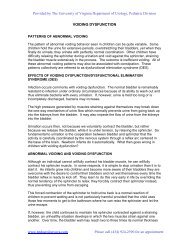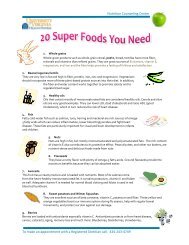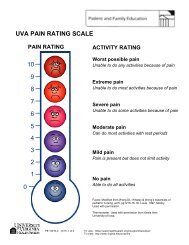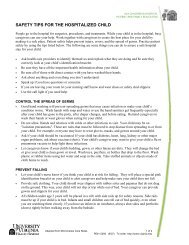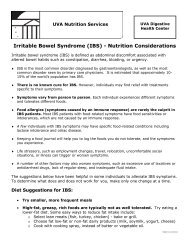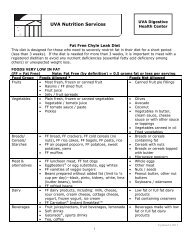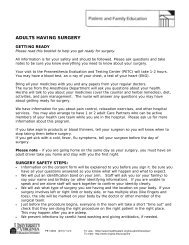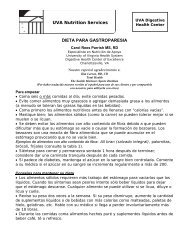Nutrition Guidelines after Gastric Bypass, Gastric Band
Nutrition Guidelines after Gastric Bypass, Gastric Band
Nutrition Guidelines after Gastric Bypass, Gastric Band
Create successful ePaper yourself
Turn your PDF publications into a flip-book with our unique Google optimized e-Paper software.
<strong>Nutrition</strong> <strong>Guidelines</strong> <strong>after</strong> <strong>Gastric</strong> <strong>Bypass</strong>, <strong>Gastric</strong> <strong>Band</strong> & <strong>Gastric</strong> Sleeve Surgery<br />
The information in this packet will help guide you immediately <strong>after</strong> your surgery and for<br />
the months and years to come. The 6 major recommendations are outlined on this page<br />
and you can find additional details about each recommendation on the following pages.<br />
The Bariatric Surgery Dietitians are always available to answer questions by phone at<br />
434-243-9348 and will see you during clinic visits.<br />
1. Diet Progression<br />
After 1-2 meals of Phase 1: Clear Liquids, you have advanced to Phase 2:<br />
Blended/Pureed.<br />
Continue the Phase 2 Diet until your first clinic appointment <strong>after</strong> surgery (about 3 weeks)<br />
when the surgeon and dietitian can evaluate your progress.<br />
In the Phase 2 Diet, all foods must have a pureed consistency.<br />
2. High Protein Food Sources<br />
Your diet <strong>after</strong> surgery requires 60-70 grams of protein per day.<br />
High protein foods include low-fat or fat-free dairy foods, beans, eggs, nuts, peanut<br />
butter, lean meat, fish and poultry.<br />
There are many protein supplements available.<br />
3. Low-Sugar & Low-Fat Foods and Beverages<br />
High-sugar and high-fat foods and beverages will cause unpleasant side effects<br />
(“Dumping Syndrome”) and make it more difficult for you to lose weight.<br />
Read food labels to make sure your foods have less than 5 grams Total Fat and less than<br />
10 grams Sugars per serving.<br />
All beverages should be sugar-free.<br />
4. 4-6 Small Meals per Day<br />
Portion size should be ½ cup or less at every meal.<br />
Eat slowly and chew each bite well.<br />
Stop eating as soon as you feel SATISFIED.<br />
5. 48-64 oz. (6-8 cups) Fluid per Day<br />
Do not drink from 30 minutes before until 30 minutes <strong>after</strong> a meal.<br />
Avoid carbonated beverages and caffeine until Phase 4: Regular Foods.<br />
6. Vitamins and Minerals<br />
Taking vitamins every day for the rest of your life is essential to make sure you get all the<br />
nutrients your body needs.<br />
o Multivitamin with minerals (Children’s Chewable or Adult Multivitamin): one a day<br />
o Calcium Citrate with Vitamin D:<br />
<strong>Gastric</strong> <strong>Bypass</strong>: 500 mg twice a day for a total of 1000 mg per day<br />
<strong>Gastric</strong> <strong>Band</strong>/Sleeve: 500 mg once a day<br />
o Iron (ferrous gluconate): 325 mg twice a day, taken separate from calcium<br />
Only if you had <strong>Gastric</strong> <strong>Bypass</strong> surgery and are a woman still menstruating<br />
OR your blood work showed low iron levels<br />
Please save this packet and review it for the best results <strong>after</strong> your surgery!
1. Diet Progression<br />
The weight loss surgery diet is divided into four phases. The diet progression is outlined below:<br />
Phase 1: Clear Liquids (1-2 meals)<br />
- For 1-2 meals <strong>after</strong> surgery you will be given clear liquids such as water, broth, a small<br />
amount of unsweetened juices, diet Jell-O and diet drinks to see how you tolerate eating.<br />
- Sip slowly and pay attention to your feelings of fullness.<br />
Phase 2: Blended/Pureed Food (3 weeks)<br />
- For approximately 3 weeks <strong>after</strong> surgery, you will need to eat blended or pureed foods.<br />
- All the food you eat should be the consistency of thin, smooth applesauce or yogurt.<br />
- Put cooked foods in a blender, then add liquid such as skim milk, broth, fat free gravy or low<br />
fat creamy soup and blend until smooth.<br />
- Eating solid foods too soon will put pressure on the staple line and may cause breakage or<br />
leaking.<br />
Food Choose Avoid<br />
Protein and Protein<br />
Substitutes<br />
Milk and Milk<br />
Products<br />
Fruit and<br />
Vegetables<br />
Pureed fish, tuna, poultry, or pork;<br />
low fat cottage cheese; low-fat or<br />
non-fat cheese; baby-food meats<br />
(all types); mashed or pureed tofu;<br />
pureed egg or egg substitute;<br />
blended low fat casseroles with<br />
soft vegetables<br />
Fat-free (skim) or 1% milk; sugar<br />
free or low fat yogurt<br />
(approximately 80 calories per<br />
serving)<br />
Applesauce, pureed banana,<br />
mashed potato or other fruit &<br />
vegetables without seeds or hulls<br />
that have been pureed<br />
Bread and Cereals Hot cereals cooked in milk<br />
(oatmeal, grits, cream of wheat)<br />
Other Sugar free gelatin or popsicles;<br />
sugar free fat free pudding/custard<br />
Crunchy peanut butter;<br />
all others<br />
Chocolate milk;<br />
sweetened condensed<br />
milk; 2% or whole milk;<br />
ice cream<br />
All others<br />
Bread and crunchy<br />
cereals<br />
Chewing gum; sweets<br />
Sample Phase 2 Menu:<br />
Breakfast 1 package No Sugar Added Carnation Instant Breakfast made<br />
with 1 cup skim milk & 1/3 cup powdered nonfat milk<br />
Snack ½ cup cottage cheese<br />
Lunch ½ cup fat-free refried beans<br />
1 ounce melted reduced fat cheese<br />
Snack ½ cup Light yogurt<br />
Dinner 2 oz meat blended with 1/4 cup low-fat cream soup and 2 Tbsp<br />
skim milk powder<br />
This provides approximately 70 grams protein and 800 calories.<br />
Please save this packet and review it for the best results <strong>after</strong> your surgery!
Phase 3: Soft Food (1 week)<br />
- About 3 weeks <strong>after</strong> surgery, with your doctor’s approval, you may advance to Phase 3.<br />
- The general rule is “Can I mash this food with a fork?” to determine if it will be soft enough.<br />
- Phase 3 of the diet should include about 3 to 4 meals per day. Each meal should not exceed<br />
4 ounces or ½ cup.<br />
- You will need to eat and drink slowly. Take small bites and chew very well.<br />
- Keep in mind that you are “re-educating” your stomach. If you eat too fast, too much, or<br />
don’t chew enough, you will feel uncomfortable and could vomit.<br />
Food Choose Avoid<br />
Protein and Protein<br />
Substitutes<br />
Milk and Milk<br />
Products<br />
Fruit and<br />
Vegetables<br />
Lean soft and moist meats<br />
including fish, tuna, poultry, or<br />
pork; low fat cottage cheese,<br />
low-fat or non-fat cheese; soft<br />
tofu; eggs or egg substitute;<br />
soft low fat casseroles with<br />
soft vegetables<br />
Fat-free (skim) or 1% milk;<br />
sugar free or low fat yogurt<br />
(approximately 80 calories per<br />
serving)<br />
Any fruit & vegetables without<br />
seeds or hulls that have been<br />
cooked soft; soft<br />
unsweetened canned fruits or<br />
vegetables; fresh soft fruit<br />
Bread and Cereals Hot cereals cooked in milk<br />
(oatmeal, grits, cream of<br />
wheat); cold cereal (high<br />
protein) soaked in milk<br />
Other Sugar free gelatin or<br />
popsicles; sugar free fat free<br />
pudding/custard<br />
Crunchy peanut butter;<br />
fried eggs; any meat that<br />
is dry, tough or chewy.<br />
Red meat may not be<br />
tolerated in this phase.<br />
Chocolate milk;<br />
sweetened condensed<br />
milk; 2% or whole milk;<br />
ice cream<br />
All others – including raw<br />
vegetables (such as<br />
salads) and raw crunchy<br />
fruits (especially those<br />
with tough skins/ seeds)<br />
Soft “gummy” bread;<br />
crunchy cereals; sweet<br />
cereals<br />
Chewing gum; sweets<br />
Sample Phase 3 Menu:<br />
Breakfast 1 egg with 1 slice reduced fat cheese<br />
Snack 1/3 banana with 1 Tbsp Natural Peanut Butter<br />
Lunch 3 oz lean, soft meat (turkey, low-fat ham) with ¼ cup low-fat<br />
gravy<br />
¼ cup light canned fruit<br />
Dinner ¼ cup tuna canned in water with 1 Tbsp light mayo<br />
¼ cup cooked vegetables<br />
Snack ½ cup Low-fat cottage cheese<br />
This provides approximately 70 grams protein and 700 calories.<br />
Please save this packet and review it for the best results <strong>after</strong> your surgery!
Phase 4: Solid Food<br />
- About 4-6 weeks <strong>after</strong> your surgery, you may begin to try solid foods, one item at a time to<br />
test your tolerance to them.<br />
- Do not worry if you cannot handle foods that you used to eat. Most people experience some<br />
problems at first with food tolerances, especially with meats and breads.<br />
- Once you are eating solid foods you can reduce the number of meals that you eat to 3 meals<br />
per day. Be as regular as possible with meals and meal times.<br />
- You will always need to get 60-70 grams of protein per day, and if you skip meals you will<br />
not get in enough protein.<br />
Food Choose Foods that may be Foods to limit/avoid<br />
difficult to tolerate for best weight loss<br />
Protein and Lean meats, eggs or egg Tough meat or meat Fried or breaded meat<br />
Protein substitute and tofu; with gristle; Some products; fried eggs<br />
Substitutes regular low fat<br />
patients do not tolerate<br />
casseroles or crock pot<br />
meals<br />
red meat.<br />
Milk and Milk Fat-free (skim) or 1% Chocolate milk;<br />
Chocolate milk;<br />
Products milk; sugar free or low fat sweetened condensed sweetened condensed<br />
yogurt (approximately 80 milk; 2% or whole milk; milk; 2% or whole milk;<br />
calories per serving) ice cream<br />
ice cream<br />
Fruits Fresh, canned, frozen or Be cautious with apples, Fruits that have added<br />
cooked fruit<br />
grapes, or other fruits<br />
with tough peels or<br />
skins and dried fruits.<br />
sugars or sauces<br />
Vegetables Fresh, canned, frozen or Vegetables with very Fried or breaded<br />
cooked vegetables tough skins or a lot of<br />
seeds<br />
vegetable products<br />
Bread Dry, coarse, or well- Soft breads that become Sweet breads; danish;<br />
toasted bread; crispy low gummy; breads with a doughnuts; pastries<br />
fat crackers or baked lot of nuts and seeds or<br />
tortillas<br />
dried fruit<br />
Cereals All cooked and dried Cereals containing fruits Cereal with added sugar<br />
cereals without added or nuts<br />
over 10-15 grams per<br />
sugar<br />
serving<br />
Potatoes, Boiled, mashed or baked Potato skins; rice; Instant noodle dishes<br />
Rice and potatoes; well cooked noodles<br />
Pasta whole wheat pasta or<br />
rice<br />
Other Sugar free gelatin or Chewing gum; sweets; Fried, salty snack foods;<br />
popsicles; sugar free fat popcorn; nuts; chili; creamed soups unless<br />
free pudding/custard extremely spicy foods low fat versions<br />
Please save this packet and review it for the best results <strong>after</strong> your surgery!
Sample Phase 4 Menu:<br />
Breakfast ½ slice whole wheat toast<br />
1 scrambled egg<br />
1 turkey sausage patty<br />
Lunch<br />
½ sandwich (1 slice whole wheat toast with 3 thin slices lean<br />
ham, 1 slice reduced-fat cheese and 1 Tbsp light mayo)<br />
Dinner 3 ounces grilled chicken breast without skin with ¼ cup<br />
cooked vegetables sauteed in 1 Tbsp olive oil<br />
Snack ¼ cup almonds<br />
This provides approximately 68 grams protein and 1,000 calories.<br />
Please save this packet and review it for the best results <strong>after</strong> your surgery!
2. High Protein Food Sources<br />
- PROTEIN will be an essential part of your diet <strong>after</strong> surgery.<br />
- Protein helps with wound healing, muscle and skin re-growth, and repair, as well as<br />
preventing hair loss.<br />
- We recommend a daily protein goal of 60 grams for females and 70 grams for males<br />
each day. Every meal and snack should have a good source of protein in it. See the list<br />
below.<br />
- Sometimes for the first 1-2 weeks <strong>after</strong> surgery it is helpful to consume a protein supplement<br />
(as long as it is low in added fats and sugars). See the list below.<br />
FOODS<br />
Beans and Nuts<br />
SERVING SIZE<br />
GRAMS OF<br />
PROTEIN<br />
Fat-free refried beans<br />
Beans (cooked)<br />
baked, black, black-eyed peas,<br />
½ cup<br />
6<br />
brown, garbanzo/chick peas,<br />
kidney, lentils, lima, pinto, white<br />
½ cup<br />
7.5 (average)<br />
Nuts & Seeds<br />
almonds, cashews, peanuts,<br />
pistachios, pumpkin seeds,<br />
sunflower seeds, walnuts<br />
1 oz. 6.5 (average)<br />
Hummus ¼ cup 4<br />
Reduced-fat peanut butter<br />
Dairy<br />
2 Tbsp 8<br />
Skim or 1% milk<br />
1 cup<br />
8<br />
Low-fat/Light yogurt 4-6 oz. 5<br />
Reduced-fat cheese 1 ounce 7<br />
Low-fat cottage cheese ½ cup 13<br />
Sugar-free fat-free instant<br />
pudding<br />
½ cup (made with skim milk) 4<br />
Carnation Instant Breakfast, No<br />
Sugar Added<br />
1 packet (made with 1 cup skim milk) 12<br />
Non-fat milk powder<br />
Meat and Seafood<br />
1 Tbsp 1.5<br />
Egg (scrambled or boiled) 1 large<br />
6<br />
Lean Beef (cooked) 1 oz. (3 oz. = size of a deck of cards) 8<br />
Lean Pork (cooked) 1 oz. (3 oz. = size of a deck of cards) 8<br />
Lean Chicken (cooked) 1 oz. (3 oz. = size of a deck of cards) 8<br />
Fish (cooked) 1 oz. (3 oz. = size of a deck of cards) 6<br />
Tuna (canned)<br />
Alternative Items<br />
1 oz. (3 oz. = size of a deck of cards) 7<br />
Egg beaters<br />
½ cup<br />
12<br />
Tofu 3 oz. (size of a deck of cards) 11<br />
Veggie burger (soy, bean,<br />
veggie)<br />
1 burger 11-16<br />
Please save this packet and review it for the best results <strong>after</strong> your surgery!
Protein Supplements<br />
A protein supplement may be beneficial during the first few weeks <strong>after</strong> your surgery if you are<br />
having trouble consuming enough protein from food. A good supplement can help you reach<br />
your daily protein needs. Follow the package directions for mixing protein supplements with food<br />
or drinks.<br />
The following is a list of some appropriate supplements, which provide protein without high<br />
amounts of sugar:<br />
Protein Supplement Amount Grams of Protein<br />
GNC 100% Whey Protein 1 scoop 20<br />
EAS AdvantEdge 100% Whey<br />
Protein<br />
1 scoop 23<br />
Beneprotein 1 scoop 6<br />
Carb Solutions Shake Mix 1 scoop 11<br />
Carnation Instant Breakfast No 1 package with 1 cup skim milk OR 12<br />
Sugar Added<br />
1 11oz. Ready-To-Drink bottle<br />
Designer Whey 1 scoop 18<br />
Isopure 1 scoop powder 25<br />
Isopure 1 20 oz. clear drink 40<br />
Unjury 1 scoop 20<br />
Twinlab 100% Whey Protein<br />
Fuel<br />
1 scoop 25<br />
Body Fortress Super Advanced<br />
Whey Protein<br />
1 scoop 26<br />
Optimum <strong>Nutrition</strong> Gold<br />
Standard 100% Whey<br />
1 scoop 24<br />
Protein supplements are available at the following stores:<br />
GNC<br />
Target<br />
Walmart<br />
The Vitamin Shoppe<br />
Sam’s Club<br />
Some drug stores<br />
Some grocery stores<br />
Please save this packet and review it for the best results <strong>after</strong> your surgery!
3. Low-Sugar & Low-Fat Foods and Beverages<br />
SUGAR<br />
- After weight loss surgery you will also need to follow a diet that is LOW IN ADDED SUGARS.<br />
This will help not only with tolerance to foods/beverages <strong>after</strong> surgery, but will also help with<br />
optimal weight loss.<br />
- Dumping Syndrome: After gastric bypass surgery, some patients experience a<br />
phenomenon known as “dumping syndrome” <strong>after</strong> eating concentrated sweets, fatty foods<br />
and/or drinking fluids with meals. This occurs when food exits the pouch rapidly and “dumps”<br />
into the intestine. This part of your intestine does not tolerate concentrated foods (sweet or fatty<br />
foods), so it immediately pulls water out of the rest of the body to dilute the food. It then rapidly<br />
flows down the remainder of the small intestine; it enters the large intestine (still flowing rapidly)<br />
and exits via the rectum. Some patients have shared stories about their dumping syndrome,<br />
describing the sudden onset of diarrhea and have reported having accidents in public places.<br />
Dumping syndrome can cause not only urgent diarrhea, but often patients will also feel nausea,<br />
lightheadedness, flushing, and stomach cramps.<br />
- Read Food Labels: Foods may have hidden sugar, so be sure and read food labels<br />
carefully. Aim for approximately 10 grams or less of sugar per serving. To prevent dumping<br />
syndrome you will need to avoid eating sugar and foods containing real sugar. Avoid products<br />
which list any type of sugar as one of the first three ingredients: including sugar, maple syrup,<br />
honey, molasses, corn syrup, corn sweeteners, glucose, lactose, maltose, dextrose, sorghum,<br />
sorbitol or mannitol.<br />
- Artificial Sweeteners: NutraSweet, Splenda, Sweet and Low and other artificial sweeteners<br />
are acceptable substitutes for real sugar. They will not cause dumping and will help with weight<br />
loss and maintenance since they contain very few calories.<br />
FAT<br />
- Your food choices will also need to be LOW-FAT. Fat may be difficult to digest or tolerate<br />
<strong>after</strong> weight loss surgery, especially fried foods, fast foods and snack foods. Small amounts of<br />
fats are fine such as those found in lean meats and fish or low fat dairy products and in fact,<br />
your body needs a certain amount of fat each day.<br />
- Cooking Methods: Use low-fat cooking methods to prevent adding fat to your foods. Try<br />
baking, broiling, or grilling and avoid frying foods.<br />
- Added Fat: A healthy, low-fat food can be made unhealthy from added fat. Be careful of the<br />
following ways that fat can be added to food: salad dressing, butter, sauces, gravies,<br />
mayonnaise, cheese, and nuts.<br />
- Read Food Labels: Read food labels for TOTAL FAT content. Total fat should be around<br />
5 grams per serving as an average.<br />
**** NOTE: If a food is labeled “Low-fat” it does not necessarily mean it is also low in sugar and<br />
vice-versa. So, it is important to read the entire food label.<br />
Please save this packet and review it for the best results <strong>after</strong> your surgery!
4. 4-6 Small Meals per Day<br />
- The diet has been designed to be gentle on your “new” stomach, to ensure proper healing of<br />
the staple line, and to help you to avoid overeating.<br />
- A normal stomach can hold approximately 4-6 cups at a time. After surgery your stomach<br />
pouch will only be able to handle about ½ cup!<br />
o You will need to GO SLOW!<br />
o It is important to chew your foods well, eat very slowly and pay attention to how you<br />
are feeling. Stop eating as soon as you feel full.<br />
5. 48-64 oz. (6-8 cups) Fluid per Day<br />
- Weight loss surgery patients need to drink AT LEAST 6-8 cups of LOW calorie fluids per<br />
day to prevent dehydration. (See list below.)<br />
- Do not drink fluids for 30 minutes before meals, during meals, or for 30 minutes <strong>after</strong> a meal.<br />
o Drinking too close to a meal may overfill the stomach pouch and cause vomiting. It<br />
can also cause the food to be washed through the intestines too quickly and may<br />
cause Dumping Syndrome or may leave you feeling hungry more quickly.<br />
- Sip slowly, but consistently between meals.<br />
- You may not be able to tolerate carbonated beverages or caffeine until you are in Phase 4.<br />
Beverages to Choose:<br />
WATER is best!!<br />
Flavored Water (Fruit2O, Sparkling)<br />
Crystal Light<br />
Wyler’s<br />
Juices Minute Maid Light<br />
Diet Juices<br />
Diet V8 Splash<br />
Sports Drinks Gatorade G2<br />
Propel<br />
Vitamin Water Zero<br />
Powerade Zero<br />
Soft Drinks Diet soft drinks<br />
“Zero” soft drinks<br />
Coffee & Tea Diet Iced Tea<br />
Unsweetened Tea<br />
Coffee with sugar-free, fat-free creamer and sweetener<br />
Milk Skim or 1% milk<br />
Light Soymilk<br />
Other Sugar-free Kool-Aid<br />
Sugar-free, fat-free hot chocolate<br />
Diet Snapple<br />
Fuze<br />
**If a beverage is “sugar-free” or “diet”, it is a good choice for you!<br />
**Sweeteners can be used: Equal, Sweet N Low, Splenda, Stevia, NutraSweet<br />
Please save this packet and review it for the best results <strong>after</strong> your surgery!
6. Vitamins and Minerals<br />
- It is critical that you take vitamins every day for the rest of your life <strong>after</strong> any weight loss<br />
surgery. You will not be able to meet your daily requirements for vitamins and minerals with<br />
food because of malabsorption <strong>after</strong> gastric bypass surgery and because you will not be able<br />
to eat a lot of food with any weight loss surgery.<br />
Daily Vitamin Regimen<br />
Complete Multiple<br />
Vitamin With<br />
Minerals<br />
500mg Calcium<br />
with Vit D<br />
1000mg Calcium<br />
Citrate with Vit D<br />
<strong>Gastric</strong> <strong>Bypass</strong> **<br />
<strong>Gastric</strong> <strong>Band</strong> &<br />
<strong>Gastric</strong> Sleeve <br />
** Iron only needs to be taken by menstruating females and those who are anemic.<br />
Iron should be in the form of ferrous gluconate or ferrous fumarate.<br />
Notes:<br />
Avoid Mens formula vitamins and “Silver” vitamins for those over 50 years<br />
old…these typically do not contain iron.<br />
Calcium should be taken in 500mg doses. So, if you need 1000mg daily, you<br />
will need to take calcium 2 times a day.<br />
Avoid taking iron and calcium at the same time since they cannot both be<br />
absorbed at the same time.<br />
<strong>Gastric</strong> <strong>Bypass</strong> Daily Supplements Example<br />
At Breakfast: Take 1 multivitamin and 2 calcium tablets.<br />
At Lunch: Take 2 iron tablets (if needed).<br />
At Dinner: Take 2 calcium tablets.<br />
<strong>Gastric</strong> <strong>Band</strong> & Sleeve Daily Supplements Example<br />
At Breakfast: Take 1 multivitamin.<br />
At Dinner: Take 2 calcium tablets.<br />
Iron<br />
Please save this packet and review it for the best results <strong>after</strong> your surgery!





